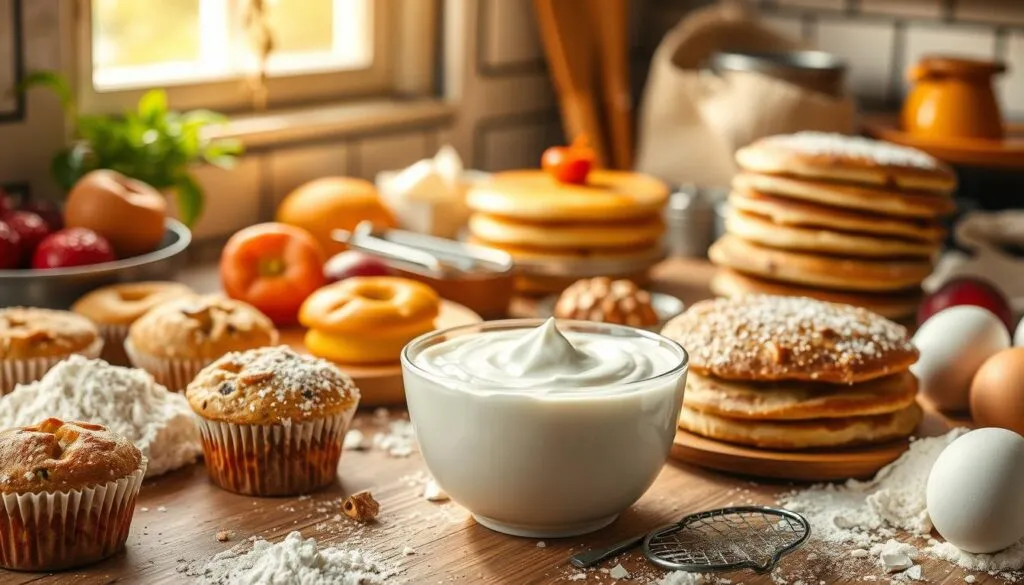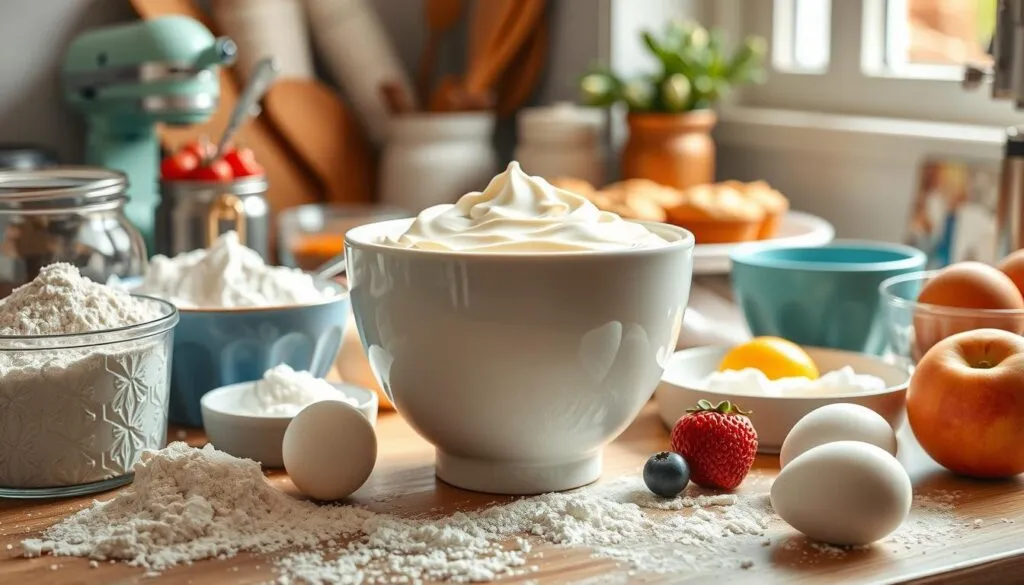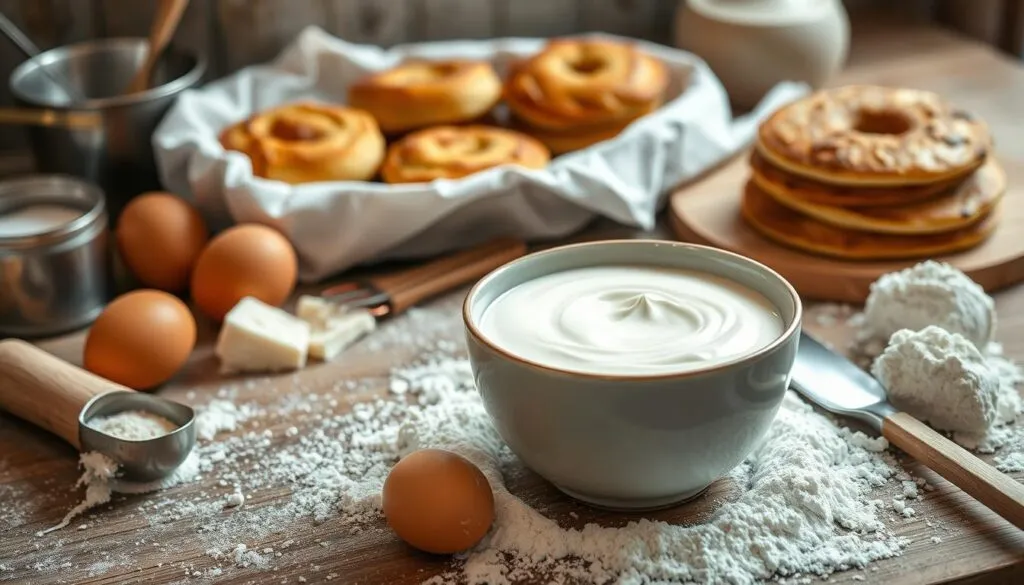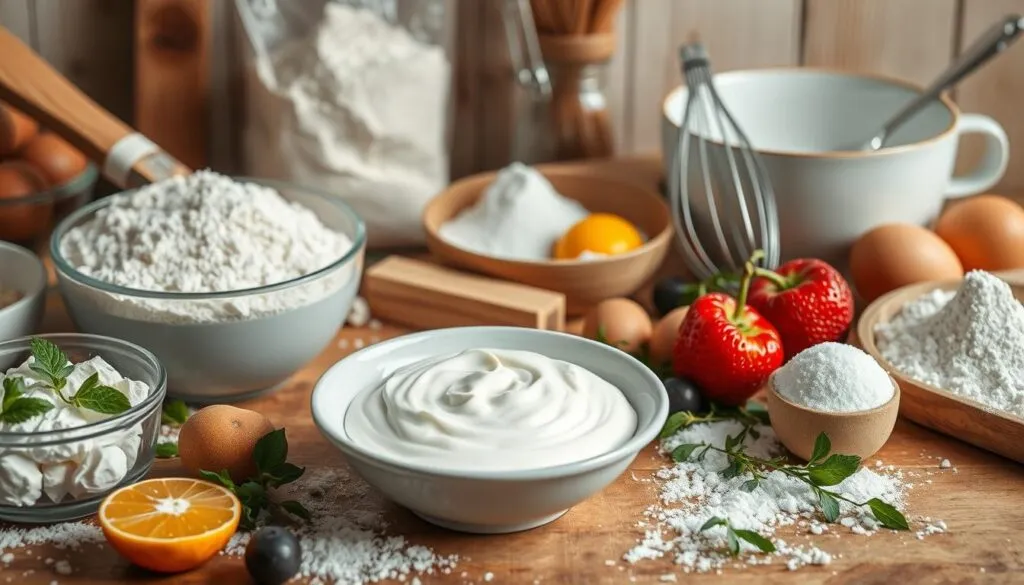When you think about baking, yogurt might not be the first thing that comes to mind. But it can really change the game. It’s great for cutting down on fat and calories in your baked goods. So, is yogurt good for baking? Yes, it is, and it’s a fantastic substitute for other ingredients.
Yogurt in baking makes treats moist and tasty, without needing extra fats and sugars. As you try baking with yogurt, you’ll see its many benefits. It’s perfect for baking because of its high water content and acidity. Plus, it’s full of nutrients, making it a healthier choice for baking.
Yogurt is a versatile ingredient for many recipes. It’s perfect for cakes, muffins, or breads, helping you make healthy treats. So, if you’re wondering if yogurt is good for baking, the answer is a big yes. It’s time to explore the benefits of yogurt in your baking.
Understanding Yogurt’s Role in Baking
Yogurt is a great addition to baking, adding moisture, tenderness, and flavor. It’s important to know how yogurt works with other ingredients. The acidity in yogurt, for example, makes baked goods light and fluffy. The water in yogurt keeps them moist and tender.
Choosing the right yogurt for baking is key. Greek yogurt is a top pick because of its high protein and thick texture. Regular yogurt, with more water, is thinner and not as thick as Greek yogurt.
Chemical Properties of Yogurt
The acidity and water content of yogurt are key in baking. The acidity balances the pH level, while the water keeps things moist. It’s vital to consider these when using yogurt in recipes.
How Yogurt Interacts with Other Ingredients
Yogurt works differently with ingredients based on its type and the recipe. Its acidity can make baked goods light and fluffy. The water content keeps them moist. Understanding these interactions helps in choosing the right yogurt for your baking.
Types of Yogurt Suitable for Baking
Many yogurts are good for baking, like Greek, regular, and flavored yogurts. Pick the right one based on your recipe’s needs. Greek yogurt is great for creamy textures, while regular yogurt works better for lighter textures.
- Choose the right type of yogurt for the recipe
- Consider the acidity and water content of the yogurt
- Balance the pH level in your baked goods

By using these tips and understanding yogurt’s properties, you can make delicious, moist baked goods. Yogurt is versatile, making it perfect for snacks or desserts. With the right yogurt and techniques, you can impress with your baking.
The Science Behind Using Yogurt in Baked Goods
Using yogurt in baking can really change the game. Michigan State University Extension says it can cut down on fat and calories. Greek yogurt, being high in protein and low in calories, makes baked goods moist and tasty with fewer calories.
The magic of yogurt in baking comes from its chemistry. Its acidity and water content make it a great swap for fats and sugars. For instance, Stonyfield suggests using yogurt instead of sour cream or mayonnaise. This cuts calories and adds a tangy taste to your treats.
Some perks of yogurt in baking include:
- Less fat and calories
- More moisture and flavor
- Better texture and structure
Remember, different yogurts might need different water amounts. Greek yogurt, for example, is thicker and might need more water. With a bit of practice, you can make yummy, healthy baked goods for everyone.

Benefits of Using Yogurt in Your Baking
Yogurt adds moisture and texture to baked goods. It also brings nutritional benefits and enhances flavors. Using yogurt in baking can make your treats healthier and tastier. It’s a great substitute for milk or sour cream, reducing fat content.
Yogurt can make baked goods 25% more moist, making them tender and flavorful. It can even replace up to 50% of flour, creating lighter textures. This is better than using milk, as yogurt has fewer calories but similar consistency.
Moisture and Texture Enhancement
Yogurt’s high water content keeps baked goods moist. Its acidity works with baking soda, making them light and fluffy. It’s perfect for cakes, muffins, and breads.
Nutritional Advantages
Yogurt adds protein and calcium to baked goods. Greek yogurt is high in protein and low in calories. It’s great for healthier baked goods.
Flavor Development
Yogurt enhances the flavor of baked goods, adding a tangy taste. It’s perfect for pancakes or waffles, adding depth and complexity.

| Ingredient | Benefits |
|---|---|
| Yogurt | Moisture and texture enhancement, nutritional advantages, flavor development |
| Greek Yogurt | High in protein, low in calories, can replace up to 1 cup of butter in recipes |
Is Yogurt Good for Baking? The Definitive Answer
Wondering if yogurt is good for baking? The answer is yes. Yogurt is a great choice for baking. It has lots of protein and is thick, making it perfect for replacing other ingredients. This reduces fat and calories in your recipes.
Yogurt can take the place of sour cream, butter, or milk. It’s a versatile ingredient for your baking needs.
Yogurt is a good substitute for baking. It has more protein than sour cream. A 100g serving of Greek yogurt has about 3.47g of protein. Sour cream has only 1-2 grams per 2-tablespoon serving.
Yogurt also helps lower the calorie count of your recipes. A 6-ounce serving of Greek yogurt has 100 to 150 calories. This depends on the fat content.
Some benefits of using yogurt in baking include:
- Moisture and texture enhancement
- Nutritional advantages, such as increased protein and reduced calorie count
- Flavor development, with yogurt adding a tangy flavor to your baked goods

In conclusion, yogurt is a great choice for baking. It offers many benefits and is versatile. Yogurt can help reduce calories, increase protein, and add flavor to your recipes.
It’s perfect for baking a variety of treats. From cakes and muffins to breads and cookies, yogurt is a valuable addition to your baking arsenal.
How to Substitute Yogurt in Traditional Recipes
Yogurt is a great choice for baking. It cuts down on fat and calories while adding moisture and texture. You can replace butter, milk, or even eggs with yogurt in your recipes.
Replacing Butter with Yogurt
Michigan State University Extension says yogurt is a good butter substitute. Use 1/2 cup of yogurt for 1/4 cup of butter. This works well in cakes, muffins, and bread.
Using Yogurt Instead of Milk
Yogurt is also a good milk substitute. Swap 1 cup of yogurt for 1 cup of milk. It adds a tangy flavor and creamy texture to your baked goods. It’s great for pancakes, waffles, and crepes.
Yogurt as an Egg Substitute
Yogurt can also replace eggs in recipes. Use 1/4 cup of yogurt for one egg. It adds moisture and texture to your baked goods. It’s perfect for cakes, muffins, and cookies.
Yogurt is used in many baking recipes like Greek yogurt cake, yogurt muffins, and yogurt cookies. Remember, yogurt adds a tangy flavor and creamy texture. You might need to adjust the sugar or other ingredients. With a bit of experimentation, you can make delicious and healthy baked goods using yogurt.
| Substitution | Ratio | Example |
|---|---|---|
| Butter with Yogurt | 1/2 cup yogurt : 1/4 cup butter | Cakes, muffins, bread |
| Milk with Yogurt | 1 cup yogurt : 1 cup milk | Pancakes, waffles, crepes |
| Egg with Yogurt | 1/4 cup yogurt : 1 egg | Cakes, muffins, cookies |
Best Practices for Baking with Greek Yogurt
Choosing the right yogurt is key when baking with Greek yogurt. Its high protein and thick texture make it perfect for baking. Stonyfield suggests using Greek yogurt as a sour cream or mayonnaise substitute, a great tip for baking.
Here are some tips for baking with Greek yogurt:
- Choose a Greek yogurt with at least 2% fat for the best results.
- Don’t overmix the batter, as this can result in a dense final product.
- Allow the cake to cool for 10-15 minutes before slicing to ensure it retains its moisture.
Using Greek yogurt in baking can make your treats healthier. Swapping sour cream for Greek yogurt in recipes can cut calories and fat. It also keeps soups creamy without the extra fat of half-and-half. These tips will help you make the most of Greek yogurt in your baking.
By following these tips, you can bake delicious, healthy treats for any event. Greek yogurt is a great addition to cakes, muffins, or bread. With these guidelines, you’ll master baking with Greek yogurt and find the best yogurt for your recipes.
Common Mistakes to Avoid When Baking with Yogurt
When baking with yogurt, knowing common mistakes is key. Temperature is very important because yogurt can be sensitive to heat. Michigan State University Extension warns that using yogurt in baking can be tricky.
Stonyfield notes that Greek yogurt is sensitive to temperature and mixing. To avoid mistakes, it’s important to use the right yogurt and measure it correctly. Baking with Greek yogurt needs careful attention because it’s more temperamental than other yogurts.
Some key considerations when baking with yogurt include:
- Using the right type of yogurt, such as plain or Greek yogurt, depending on the recipe
- Measuring yogurt accurately to ensure the right consistency
- Avoiding high temperatures, which can cause yogurt to curdle or separate
By following these tips and being mindful of common mistakes, you can succeed in baking with yogurt. Whether you’re using yogurt vs milk in baking or substituting it for other ingredients, understanding how yogurt behaves is key. Adjust your technique based on the recipe.
Popular Baked Goods That Work Best with Yogurt
Yogurt is a great addition to many baked goods. It can replace oil or butter, adding moisture and flavor. A simple yogurt cake recipe mixes dry ingredients like flour and sugar with wet ingredients like yogurt and eggs.
Yogurt bread is another favorite. It combines yogurt with flour, yeast, and other ingredients. This bread is a healthy alternative to traditional bread. Yogurt can also make delicious cookies and muffins. By trying different recipes, you can make tasty treats for any occasion.
- Cakes: such as vanilla or chocolate cake
- Breads: such as whole wheat or sourdough bread
- Cookies: such as chocolate chip or oatmeal cookies
- Muffins: such as blueberry or banana muffins
Adding yogurt to your baking makes treats moist and delicious. Whether you’re making a simple cake or a complex bread, there are many options. So, why not try baking with yogurt and see what tasty creations you can make?
| Baked Goods | Yogurt Content | Prep Time | Cook Time |
|---|---|---|---|
| Cake | 1 cup | 10 minutes | 30-40 minutes |
| Bread | 1/2 cup | 15 minutes | 40-50 minutes |
| Cookies | 1/4 cup | 5 minutes | 10-15 minutes |
| Muffins | 1/2 cup | 10 minutes | 20-25 minutes |
Conclusion: Making the Most of Yogurt in Your Baking Adventures
Yogurt is an incredibly versatile ingredient that can take your baking to new levels. It adds moisture, texture, and nutrition to your recipes. By using the tips from this article, you can make delicious and healthy baked goods.
Understanding yogurt’s unique properties is key to baking success. Experiment with different types of yogurt to find the best for your recipes. From creamy Greek yogurt to tangy plain, there’s a type for every need. With practice, you’ll find many ways to use yogurt in your favorite treats.
Start your baking adventures with yogurt and discover a world of tasty possibilities. Enjoy the benefits and versatility of yogurt in your kitchen. Happy baking!
FAQ
Is yogurt good for baking?
Yes, yogurt is great for baking. It has acidity and water, making it a good substitute for fats and sugars.
What are the benefits of using yogurt in baking?
Yogurt adds moisture and texture to baked goods. It also brings nutritional benefits and enhances flavors. Its water content keeps things moist, and its acidity makes them light and fluffy.
How can yogurt be used as a baking substitute?
Yogurt can replace butter, milk, and even eggs in baking. This reduces fat and calories while adding moisture and texture.
What is the best way to bake with yogurt?
To bake with yogurt, choose the right type and measure it correctly. Follow temperature and storage guidelines for the best results.
What are the best types of yogurt for baking?
Greek yogurt is a popular choice for baking. Different yogurts offer unique benefits. The best one depends on your recipe’s needs.
Can I use yogurt in baking recipes?
Yes, yogurt works well in many baked goods. It improves moisture, texture, and quality in both sweet and savory treats.
How does yogurt affect the texture of baked goods?
Yogurt’s acidity and water content make baked goods moist and tender. Its acidity also helps with a light and fluffy texture.
Can I substitute yogurt for milk in baking?
Yes, yogurt can replace milk in many recipes. Adjust other ingredients as needed due to yogurt’s water and acidity content.
What is the best way to bake with Greek yogurt?
Baking with Greek yogurt requires careful handling. Choose the right type, mix it well with other ingredients, and adjust the recipe as needed.
What are some common mistakes to avoid when baking with yogurt?
Be careful with temperature, measurements, and storage when baking with yogurt. Avoiding these mistakes ensures your baked goods turn out right.

